Rocketing to the Top: Kate Anderson Launched Her Career by Aiming High
She Is Among NREL’s 2024 Distinguished Researchers
As a young girl growing up in Connecticut, National Renewable Energy Laboratory (NREL) Strategy Lead Kate Anderson dreamed of becoming an astronaut.
“I went into the Air Force ROTC in college [at MIT while studying aerospace engineering] and envisioned becoming an astronaut someday,” she said.
There were not any space travelers in her immediate family. However, an uncle who worked as an airline pilot connected Anderson with astronaut Eileen Collins. “I got to go down to tour NASA with her, and I went to Space Camp in Alabama,” Anderson said. Liftoff seemed possible.
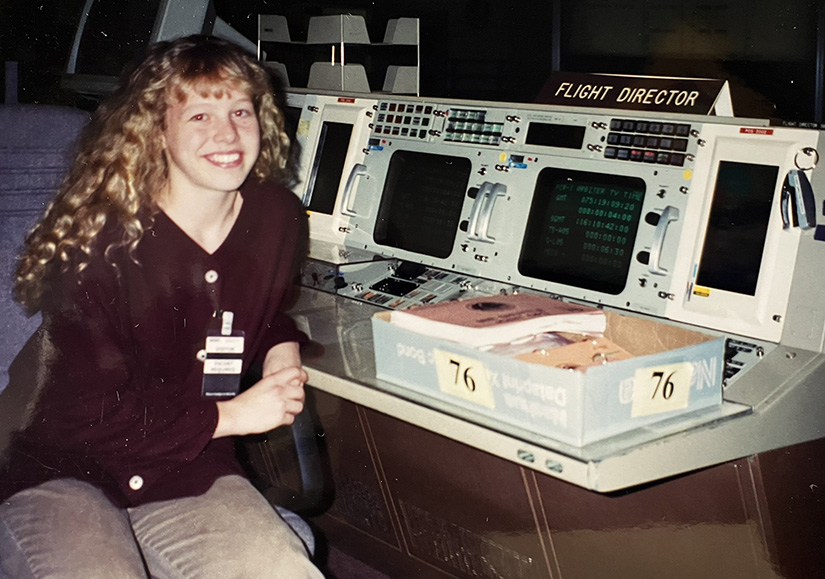
Anderson, who dreamed of being an astronaut, toured NASA as a high schooler in 1995. Photo by Kate Anderson, NREL
And, indeed in college, as part of her aerospace engineering training, she was a passenger on a large training plane known as the “Vomit Comet,” which made a rapid nosedive to simulate a loss of gravity. The plunge lasted only 35 seconds—but that was plenty. “It was tough. Hard to keep your lunch down when you’re diving toward the earth,” she explained.
However, the most common route to becoming an astronaut was to be a pilot, and although she played sports in college, Anderson did not qualify for pilot training because her eyesight was bad. Disappointed, she opted for satellite launching and was assigned as a captain to Kirtland Air Force Base in New Mexico, home to a space and missile program.
Once there, she met her future husband, Mark, a mechanical engineer also in the Air Force. In a way, she was able—by proxy—to fulfill part of her early dream about space travel. She also gained a lot of experience as a 21-year-old.
“They handed me a satellite launch program,” she said, a position that included overseeing contractors and traveling to launch sites around the country. “It was a pretty cool assignment.”
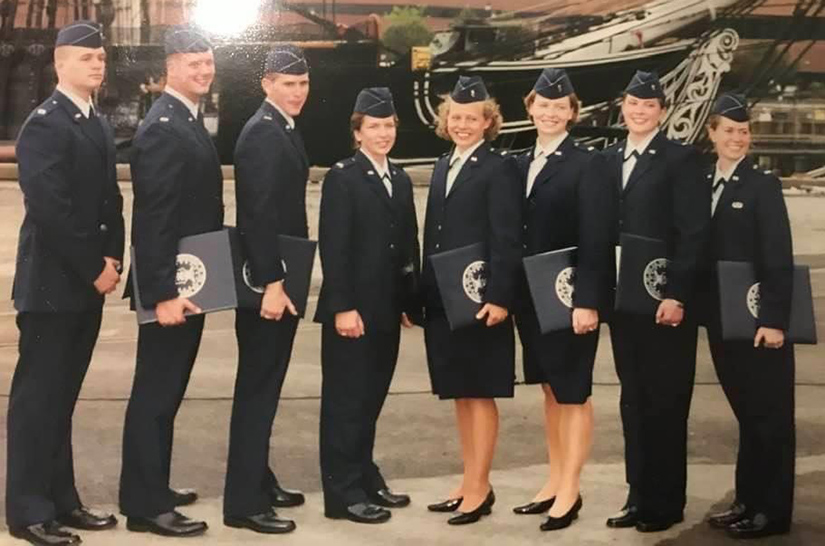
Anderson was commissioned as a 2nd lieutenant in the Air Force upon graduation in 2000 from MIT. The ceremony took place at the USS Constitution in Boston, Massachusetts. Photo by Kate Anderson, NREL
Anderson’s program used refurbished missiles that were being replaced because they were outmoded. She helped provide launch platforms for university research experiments. “It was a cheap ride into space for them,” she said, while also giving a useful purpose to the rockets.
Once she had completed her four-year stint, she and Mark took a year from 2004 to 2005 to travel around the world—often to remote areas for rock climbing. Her husband, who is passionate about climbing, taught Anderson the sport. “I think it was because he wanted a reliable belayer,” she laughed.
The Pull to Renewable Living and NREL
Although Anderson had not thought much about renewable energy as a younger woman, the idea of pursuing a sustainable lifestyle sprouted while she was stationed in Albuquerque with the Air Force.
Anderson admired the tradition of green building in New Mexico, a state that features an array of structures such as straw-bale homes, adobe dwellings, and so-called Earthships. After taking a weekend class on Earthship construction—a building method of reusing materials such as old tires to make more sustainable housing—she was hooked.
“That led me to looking for a master’s program,” she said. Failing to find a suitable one in green building, she settled for graduate work in renewable energy systems. “That helped me transition out of space and into sustainability.”
After a few more years in New Mexico as civilians, Anderson said, “Mark ran out of rocks to climb—so we were either going to go to Utah or Colorado. Both are big climbing destinations.”
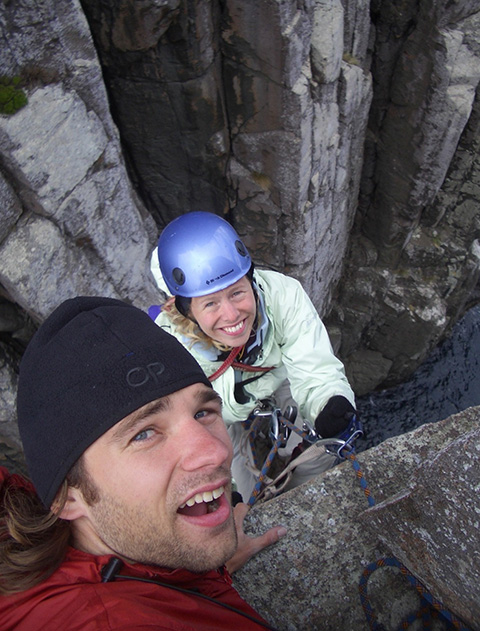
Anderson and her husband Mark rock climbed in Tasmania during their trip around the world in 2004. Photo from Kate Anderson, NREL
In 2008, Anderson landed at NREL, working in the deployment area, which was part of the analysis team. She began under Nancy Carlisle in the integrated application office. It was a perfect fit. Carlisle had built her own net-zero house, so “we connected over sustainable building,” Anderson said.
For her part, Carlisle is proud of mentoring Anderson.
“Kate’s work is unique because she is able to lead project teams to develop specific engineering solutions to address real-world problems involving the integration of renewable energy on the grid,” Carlisle said. “She has a unique ability to sort through complex issues and get to the heart of the problem and clearly document a path forward.”
One of her early NREL projects was collaborating with the government of New York City to increase the Big Apple’s use of solar energy and resilience techniques. Another was joining Walker in renewable energy optimization analysis for the National Zoo in Washington, D.C., which was trying to get to net-zero energy use. The team looked at all forms of renewables, including solar power, wind energy, and biomass to meet this goal.

Anderson visited Fort Carson, Colorado, to inspect a photovoltaic array damaged by hail. She is shown with garrison commander Col. Wortinger. Photo by Dennis Schroeder, NREL
To keep track of the process, Walker created a renewable energy optimization spreadsheet, a tool that evolved into Renewable Energy Optimization (REopt). Anderson, in on the ground floor, later served as lead of the REopt team for more than a decade. She remained in that area of renewable energy adoption until a few years ago. Anderson also was a senior engineer and manager of the NREL Modeling and Analysis Group for 13 years.
More recently, she took on the role of inaugural Energy Systems Integration chief of staff, energy justice lead, and principal investigator for LA100 Equity Strategies. That study developed new research approaches for integrating equity in the energy transition allowing Los Angeles to depend on 100% clean energy.
Her contributions are one reason she was selected in the 2024 cohort of NREL’s distinguished researchers. “Kate is most deserving of this honor,” Dave Mooney said. “Her leadership in developing tools that have become instrumental to accelerating the energy transition exemplifies what it means to be an NRELian.”
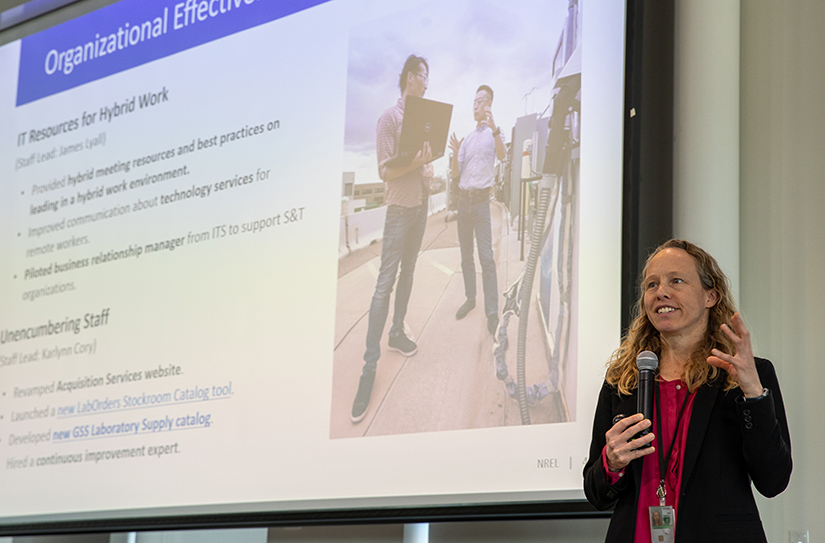
Anderson addresses NREL staff during a meeting. Photo by Brittany Falch, NREL
A Strategist in Many Roles
Her early aspirations may have helped set a lofty perspective.
As NREL’s strategy lead, she is aligning and integrating research across the laboratory’s top 12 goals to achieve NREL’s critical objectives.
“My role as strategy lead is to help figure out how we achieve our grand vision of a clean energy future for the world,” she said. “I find it super inspiring.”
The equity piece is crucial to those goals, she said. “When you say a clean energy future for the world—with the ‘world,’ you are talking about everybody,” Anderson said. “Today, most of our renewable technologies reach wealthier people and communities who can afford them.” First adopters, she noted, are important, but equally necessary will be bringing the benefits to everyone.
Looking ahead, Anderson aspires to ensuring that the laboratory commits to its ambitious vision. As a parent of a 13-year-old daughter and 10-year-old son, she and her husband know that the stakes are real.
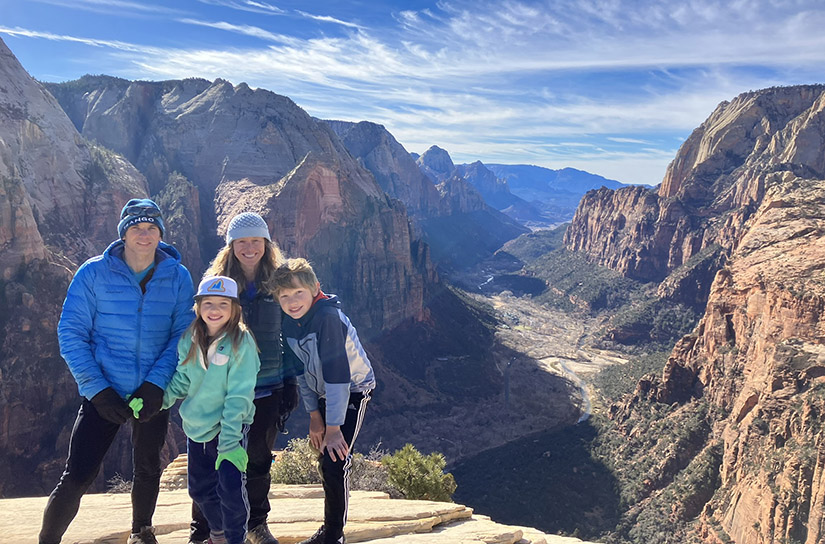
Anderson, Mark, and their two children pose at the top of Angels Landing in Zion, Utah, in 2024. Photo from Kate Anderson, NREL
Anderson has stayed committed to NREL’s mission and exploring possibilities. Along the way, she earned a Ph.D. in advanced energy systems from Colorado School of Mines.
When asked to name what the most important thing that NREL needs to do, Anderson paused. Eventually, she said, “the number one thing NREL can do to achieve our vision is investing in our people.”
Who better than Anderson to help launch that experiment?
To learn more about those who influenced Anderson, including Carlisle and Walker, download a free PDF of the book Clean Energy Innovators: NREL People Working to Change the World.

